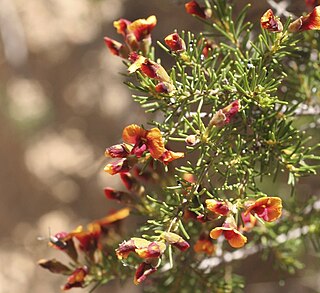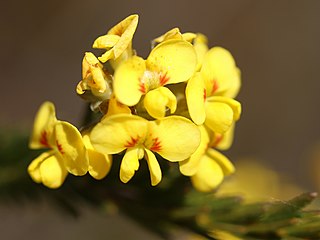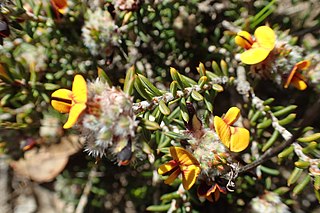
Correa pulchella, commonly known as the salmon correa, is a species of small prostrate to erect shrub that is endemic to South Australia. It has glabrous, leathery, narrow oblong to broadly egg-shaped leaves and pendulous, cylindrical, pink to red or orange flowers arranged singly on short side branches.

Dillwynia cinerascens, commonly known as grey parrot-pea, is a species of flowering plant in the family Fabaceae and is endemic to south-eastern Australia. It is an erect to low-lying shrub with linear or thread-like leaves and orange or yellow flowers.

Dillwynia laxiflora is a species of flowering plant in the family Fabaceae and is endemic to Western Australia. It is a prostrate to spreading shrub with needle-shaped leaves and yellow and red flowers.

Eutaxia parvifolia is a species of flowering plant in the family Fabaceae and is endemic to southwestern Western Australia. It is a shrub with reddish brown stems, elliptic to egg-shaped leaves with the narrower end towards the base, and mostly yellow, red or orange flowers, with yellow red or orange markings.
Persoonia pungens is a species of flowering plant in the family Proteaceae and is endemic to the south-west of Western Australia. It is an erect to spreading or low-lying shrub with densely hairy young branchlets, twisted elliptic to oblong, sharply-pointed leaves, and glabrous, bright yellow flowers borne in groups of up to five.

Dillwynia elegans is a species of flowering plant in the family Fabaceae and is endemic to eastern New South Wales. It is an erect shrub with more or less cylindrical, grooved leaves and yellow flowers with red markings.

Dillwynia acerosa is a species of flowering plant in the family Fabaceae and is endemic to Western Australia. It is an erect spindly shrub with hairy, needle-shaped leaves and yellow flowers.
Dillwynia dillwynioides is a species of flowering plant in the family Fabaceae and is endemic to the south-west of Western Australia. It is a low-lying or erect, spindly shrub with cylindrical, grooved leaves and yellow, red or orange flowers with yellow, red or orange markings.
Dillwynia divaricata is a species of flowering plant in the family Fabaceae and is endemic to the south-west of Western Australia. It is an erect, spindly shrub with cylindrical, grooved leaves and yellow flowers with brownish markings.
Dillwynia juniperina, commonly known as prickly parrotpea, is a species of flowering plant in the family Fabaceae and is endemic to south-eastern continental Australia. It is an erect, spreading shrub with rigid, linear, sharply-pointed leaves and yellow flowers with red markings.

Dillwynia uncinata, commonly known as silky parrot-pea, is a species of flowering plant in the family Fabaceae and is endemic to southern Australia. It is an erect, spreading shrub with cylindrical leaves and yellow flowers with a red centre.
Pultenaea adunca is a species of flowering plant in the family Fabaceae and is endemic to the south of Western Australia. It is an erect, spindly shrub with hairy, needle-shaped leaves and yellow and red flowers.
Pultenaea arida is a species of flowering plant in the family Fabaceae and is endemic to the south of Western Australia. It is a low, spindly, spreading shrub with small, flat, hairy leaves and yellow, red or orange flowers.

Pultenaea barbata is a species of flowering plant in the family Fabaceae and is endemic to the south of Western Australia. It is a prostrate or spreading, spindly shrub with hairy, needle-shaped leaves and yellow, red, orange or brown flowers with red or yellow markings.
Pultenaea brachyphylla is a species of flowering plant in the family Fabaceae and is endemic to the south of Western Australia. It is an erect, spindly shrub with cylindrical, grooved leaves and yellow, orange and brown flowers.
Pultenaea brachytropis is a species of flowering plant in the family Fabaceae and is endemic to the south-west of Western Australia. It is an erect, spindly shrub with more or less cylindrical, grooved leaves and yellow, red and orange flowers.
Pultenaea calycina is a species of flowering plant in the family Fabaceae and is endemic to near-coastal areas in the south of Western Australia. It is an erect, spindly shrub with flat or more or less cylindrical, grooved leaves and yellow and orange flowers.

Pultenaea elachista is a species of flowering plant in the family Fabaceae and is endemic to southern Australia. It is an erect, spindly shrub with hairy foliage, oblong to egg-shaped leaves with a pointed tip, and yellow flowers with red or orange markings.

Pultenaea empetrifolia is a species of flowering plant in the family Fabaceae and is endemic to the south-west of Western Australia. It is a spindly, prostrate or spreading shrub with down-curved, cylindrical, grooved leaves and yellow to orange and red flowers.
Gompholobium pungens is a species of flowering plant in the family Fabaceae and is endemic to the south-west of Western Australia. It is an erect, openly-branched shrub with spiny stems, pinnate leaves and mostly yellow, pea-like flowers with pink or purple markings.











